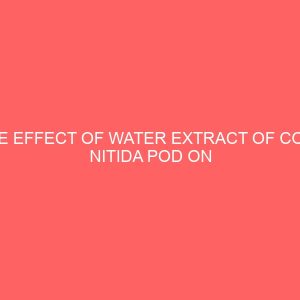Description
CHAPTER ONE
INTRODUCTION
- Background of Study
This research is on packed bed reactor system study on the biosorption of CR(vi) from aqueous solution using corn cob powder. Over the last three decades there has been increasing global concern over the public health impacts attributed to environmental pollution. The World Health Organization (WHO)estimates that about a quarter of the diseases facing mankind today occur due to prolonged exposure to environmental pollution (WHO, 2002).
Pollution by heavy metals is one of the serious environmental threats as a result of various industrial discharges (Wang and Chen, 2009). Hexavalent chromium Cr (VI) is released into the environment by many industrial activities such as leather tanning, chrome plating, stainless steel welding, pigment production and nuclear weapon production (Gonzalez et al., 2003). Chromium exists in two oxidation states Cr(III) and Cr(VI), and the most toxic form is Cr(VI), which has been implicated in causation of liver damage, pulmonary congestion and oedema (Babu and Gupta, 2008; Raji and Anirudhan, 1998).
Pollution of water due to presence of certain heavy metal ions is a severe socio-environmental problem caused by the discharge of industrial wastewater. In view of their toxicity, non-biodegradability and persistent nature, their removal becomes an absolute necessity. However, such processes are not only expensive and highly energy intensive, but also lead to production of harmful by-products and end-products, the ultimate disposal of which again causes secondary pollution (Sen and Ghosh, 2010).
Rapid industrialization and urbanization have resulted in increased discharge of heavy metals such as lead, chromium, mercury, selenium, zinc, arsenic, gold, silver, copper, nickel, etc. into aquatic ecosystem which has become a matter of concern over the last few decades due to pollutant’s, carcinogenic and mutagenic nature(Ayres, 1992). These toxic materials are generated during mining operation, refining ores, sludge disposal, fly ash from incinerators, and the process of radioactive metal plating or the manufacture of electrical materials, metal equipment, paints, alloys, batteries, pesticides or preservatives (Trivedi, 1989).The untreated effluent from electroplating industries contains approximately 100mg/L chromium (VI) which is much higher than the permissible limit of 0.05-1mg/L (Deilippis and Pallaghy, 1994).
The process of removing heavy metal by a biological material is known as Biosorption and the biological materials used are called biosorbents. Several methods have been employed in the removal of heavy metals and other contaminants.Biological processes (biosorption, bioaccumulation and biodegradation) have been proposed as potential methods for the removal of heavy metals from the environment. However, bioaccumulation and biodegradation have been linked with some disadvantages such as resistance to microbial activity, production of by-product and/or other metabolites with higher toxicity than primary substrate (Ramsay and Nguyen, 2002). Thus, biosorption is considered to be one of the promising processes for removing hazardous and environmentally undesirable chemicals (Hu et al., 2010). Mohantyet al. (2005) showed some of the advantages of biosorption method, which include removal of both organic and inorganic constituents even at very low concentrations, its relative ease and safe to operate, usage of both batch and continuous equipment with no sludge formation, and the adsorbent can be regenerated and reused.
Various biosorbents like bacteria, fungi, yeast, agricultural by product, industrial wastes, etc. have been used for biosorption (Gadd, 1993). Biosorption of toxic metals is based on a non-enzymatic process such as adsorption. Adsorption is due to the non-specific binding of ionic species to cell surface associated or extracellular polysaccharides or proteins (Volesky, 1990). Bacterial cell wall, the polysaccharides and proteins present in the corn cob powder are efficient metal biosorbent that bind charged group.
The use of biosorption technology using granular and powdered activated carbon has been carried out. However, prohibitive costs limit their extensive utilization especially in developing countries. Because of growing interest, the low-cost, easily available and environment friendly agricultural residues have been tested as metal biosorbents and a number of agro-based plant waste materials, such as papaya wood (Saeedet al., 2005), and rice husk (Tarley and Arruda, 2004), coconut fibers (Espinolaet al., 1999) black gram husk (Saeed and Iqbal, 2003) have been reported as potential biosorbents.
This report focuses on the investigation of the potential of corn cob also known asZea mays cob for the removal of chromium VI ions from aqueous solution. The polysaccharides and protein present in Zea mays cob were reported to be efficient metal biosorbent that bind to the charged group of these toxic metal. (Gibson and Benson, 2002).
The abundance of corn cob in most developing countries as well as its composition and cost effectiveness make it a strong candidate to be used as an adsorbent for removal of many pollutants from aqueous solutions. The current economic values of corn cob are less than the apparent cost of collection, transportation and processing for beneficial use (Tsai et al., 2001). Thus, corn cob has been used as fertilizer and soil conditioners by land application, as animal and poultry bedding, as fiber and roughage in animal feed (Bagby and Widstrom, 1987) and as energy source by combustion (Lin et al., 1995). However, direct utilization of corn cob as metal biosorbent may be economical, practical and useful.Thus thisstudy aims at exploring the feasibility of using corn cob as an adsorbent for the uptake ofChromium (VI) from aqueous solution. Also, the effects of various factors including pH, contact time, temperature and adsorption isotherms on the uptake will be investigated.
- Statement of Research Problem
Chromium is one of the major pollutants in the environment and is frequently present in wastewaters from various industrial units. Chromium is a toxic metal of widespread use and it exists in several oxidation states. Among the several oxidation states, Cr (VI) is considered to be the most toxic. It is usually associated with oxygen as chromate (Cr042-) or dichromate (Cr072-) ions. The Hexavalent form of chromium is considered to be a group “A” human carcinogen because of its mutagenic and carcinogenic properties (Helmer and Bartley, 1971). The untreated effluent from electroplating industries contains approximately 100mg/L chromium (VI) which is much higher than the permissible limit of 0.05-1mg/L (Deilippis and Pallaghy, 1994).
The persistent nature of Cr (VI) makes it accumulate in the food chain which with time reaches harmful levels in living beings resulting in serious health hazards such as irritation in lungs and stomach, cancer in digestive tract, low growth rates in plants and death of animals(Park et al., 2004). Therefore, removal of Cr(VI) from wastewater, prior to its discharge into natural water systems, adjoining landmasses and sewer systems, requires serious and immediate attention. The contaminated corn cob powder can now be properly disposed in such a way as to prevent it from being introduce into natural waters and accumulating in the food chain. Also, it can be recycled and channeled into other means of chemical production.
- Justification
Corn is a staple food in the northern part of Nigeria; it is produced in large quantity which leads to the availability of corn cobs in large quantity that could always be put into use. It contains cellulose and hemicelluloses, which have adsorption and biosorption properties; hence can bind to Cr(VI) ions. Corn cobs are common wastes found in our environment; hence can help convert waste into useful form. Cr(VI) adsorption has been carried out using other biosorbent e.g. Neem saw dust (Vinodhini and Nilanjana, 2009) hence the need to investigate the ability of corn cob powder in adsorption of Cr( VI) is imperative. Continuous reactors are generally able to cope with much higher reactant concentrations due to their superior heat transfer capacities(Jameset al., 1975). Continuous reactors make higher mixing rates possible. The output from a continuous reactor can be altered by varying the run time. This increases operating flexibility for manufacturers.Despite the demonstration of the efficiency of corncob to bioremediateCr (VI) using batch process (Sallauet al., 2012), there is no information of the biosorption of Cr(VI) using corn cob in a continuous process. Therefore, this study may create a method that will assist industries in reducing toxicity of waste water containing Cr (VI).
- Aim and Objectives
- Aim
The aim of this study was to examine the potential of corncob powder in the biosorption of chromium (VI) in aqueous solution in a continuous bioreactor process.
- Specific Objectives
The specific objectives of this study are:
- To investigate the effect of some operating parameters such as mass of corn powder, flow rate, influent solution pH and temperature on chromium (VI) removal by corn cob powder in the column.
- To compare the absorptive properties of corncob powder with activated carbon, a standard synthetic adsorbent used in industries.
- To compare the potentials of corncob powder in removal of chromium (VI) from synthetic chromium (VI) Solution and industrial waste containing chromium (VI).
- To carry out Fourier transform infrared spectroscopy (FTIR) of the biosorbent before and after biosorption.
- To carry out adsorptionisotherm studies of the biosorption process.







